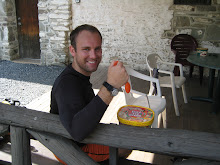I've got some loose ends to tie up at home and a few last gear essentials to get before packing for the hike. And then it's Week 1 on the trail: One foot in front of the other, just like last June, and getting reoriented.
My first decision as a hiker upon reaching Georgia will be whether to hike or not to hike the Approach Trail.
Nobody I met WV->ME '09 made an urgent case for doing so. It's not like anyone's more impressive for hiking 2,187.9 miles instead of 2,179.1 miles. But I will have the time, since I'm starting fairly early in the season, and I think it'll be good practice for me.
The first white blazes marking the Appalachian Trail appear on Springer Mountain. Like Mt. Katahdin in Maine, the peak lies within a state park with no direct road service to the top. At minimum it's a one-mile hike from a forest road to the peak.
The Approach Trail starts 8.8 miles south of Springer at the visitors center of Amicalola Falls State Park. By the time the trail reaches the peak of Springer [elevation 3,782 feet], it has crossed four roads, passed two shelters and climbed 2,000 feet in elevation.
By contrast, my first day in Maryland took me from 263 feet, over the Potomac River, to a high point of 1,600 feet, over 16 miles of hiking.
Georgia has 176 miles of AT plus the Approach.
The Appalachian Trail in Georgia means 5 things: 1. Chattahoochee, 2. Mountains, 3. Black Bears, 4. Newbies and 5. maybe snow?
- Chattahoochee. A 74-year-old national forest in northern Georgia.
- Mountains. The trail in the south hits its first 4,000-footer, ominously-named Blood Mountain, 28 miles after Mile 0 and goes on to tap four more 4,000-footers: Blue Mountain, Rocky Mountain, Tray Mountain Kelly Knob. By contrast, my first 4,000-footer on the northern half of the trail was Moosilauke - two months into my hike! The hiking in Georgia is less of a roller coaster than New Hampshire. The lowest the trail gets after Springer is 2,500 feet.
- Black Bears. Companion: "With the loss of habitat from development in the mountains, black bears are roaming farther in search of food. To combat this problem, the GATC and the USFS are placing bear cables for hanging food at the shelters most affected." Normal black bear rules apply: Make noise so they hear you coming and get out of the way, no eye contact and back off if you surprise them and stand tall if they charge.
- Newbies. Last year the received wisdom that the Recession would send a tumult of hikers onto the trail proved unfounded: It was just like any other year, according to a conversation I had at the ATC in Harper's. That means roughly 1,200 hikers starting the trail in the spring. The peak is March 15 or so. I met hikers in the northern half who started anywhere from March 2 to May. Last June I started hiking and met seasoned hikers who had internalized the thru-hiker culture, etiquette, and ethics. The also-rans had already also-ran and left the trail. This time? Not so. Should be interesting. Stories I heard over the summer lead me to believe so.
- maybe Snow? Pictures and stories from the Class of '09 show knee-deep snow in places in the south. A lot of winter camping, sitting around shelters in boggons and bubble coats, with early sunsets and campfires sounds like an acceptable change of pace.
Guten Freitag!

No comments:
Post a Comment